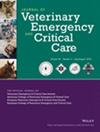在2只狗的上呼吸道创伤后使用单向说话阀进行气管造口管脱管的新方法。
IF 1.1
3区 农林科学
Q3 VETERINARY SCIENCES
引用次数: 0
摘要
目的:介绍一种新的上气道外伤犬气管切开术治疗方法。病例系列总结:两只上呼吸道外伤的狗被送到急诊科,需要立即插管。为了尽量减少镇静时间,在两只狗身上都放置了气管造口管。采用渐进式脱管方法,两只犬均接受单向说话阀,以促进逐步脱管。提供新的或独特的信息:这是第一个用于狗气管造口管管理的单向说话阀的报告。本文章由计算机程序翻译,如有差异,请以英文原文为准。
A novel approach to decannulation of a tracheostomy tube using a 1-way speaking valve after upper airway trauma in 2 dogs
Objective
To describe a novel approach to tracheostomy management in dogs with upper airway trauma.
Case Series Summary
Two dogs with upper airway trauma presented to an emergency department and required immediate intubation. To minimize sedation time, tracheostomy tubes were placed in both dogs. A stepwise approach to decannulation was initiated, with both dogs receiving a 1-way speaking valve to facilitate a gradual approach to decannulation.
New or Unique Information Provided
This is the first report of a 1-way speaking valve being used in the management of tracheostomy tubes in dogs.
求助全文
通过发布文献求助,成功后即可免费获取论文全文。
去求助
来源期刊
CiteScore
2.50
自引率
15.40%
发文量
121
审稿时长
18-36 weeks
期刊介绍:
The Journal of Veterinary Emergency and Critical Care’s primary aim is to advance the international clinical standard of care for emergency/critical care patients of all species. The journal’s content is relevant to specialist and non-specialist veterinarians practicing emergency/critical care medicine. The journal achieves it aims by publishing descriptions of unique presentation or management; retrospective and prospective evaluations of prognosis, novel diagnosis, or therapy; translational basic science studies with clinical relevance; in depth reviews of pertinent topics; topical news and letters; and regular themed issues.
The journal is the official publication of the Veterinary Emergency and Critical Care Society, the American College of Veterinary Emergency and Critical Care, the European Veterinary Emergency and Critical Care Society, and the European College of Veterinary Emergency and Critical Care. It is a bimonthly publication with international impact and adheres to currently accepted ethical standards.

 求助内容:
求助内容: 应助结果提醒方式:
应助结果提醒方式:


